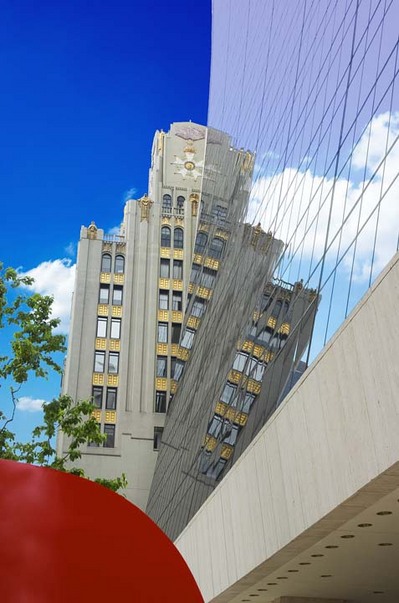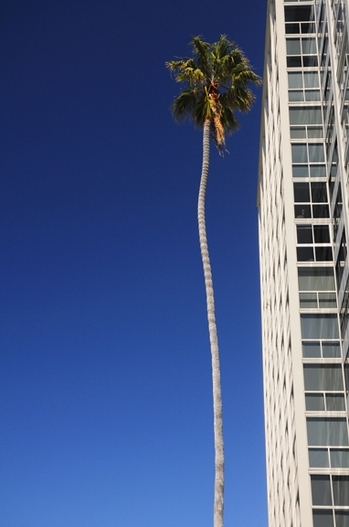Duderstadt Gallery showcases photography of Stanford Lipsey

"Salvation Army Building Reflected in Solon Building" by Stanford Lipsey.
“Affinity of Form: Photography of Stanford Lipsey” — at the University of Michigan North Campus James and Anne Duderstadt Center Art Gallery — features this contemporary photojournalist’s recent adventures in his chosen field of landscape and architectural studies.
Lipsey’s passion for this art developed when he was a photographer for the University of Michigan Daily and photography editor for the Michiganensian yearbook. He graduated from U-M in 1948 with a degree in economics.
As the exhibit’s gallery statement tells us, Lipsey joined the weekly Omaha Sun newspaper in 1953, first working as a reporter, photographer, editor, and general manager, eventually becoming the paper’s publisher and owner.
He sold the paper to Warren Buffett’s Berkshire Hathaway in 1969. And in 1973, he, Buffet, and editor Paul Williams won a Pulitzer Prize for local investigative reporting in Omaha. Afterward, Lipsey moved to upstate New York as publisher of the Buffalo Evening News when Buffet’s group purchased that paper, becoming a vice president of Berkshire Hathaway in 1988.
This exhibit consists of 48 large-scale digital images of varying formats published in his recent “Affinity of Form” monogram published by Brooklyn’s prestigious powerHouse Books.
As Anthony Bannon, director of Rochester, NY’s George Eastman House of International Museum of Photography and Film, says in an article drawn from the text, “Lipsey, the journalist, hunts, captures, and collects shards of meaning … bits of information, these elements of vision, and he plants them next to each other, each stalk growing towards the light, rooted in the belief that some things, the right things, can fit together, and thereby, that ideas can be built by coupling one image to the other.”
Bannon accurately describes Lipsey’s photography. There’s indeed a complexity in each of these 48 compositions that fuses idea and form in complicated ways — only seemingly simple because of their reliance upon repetitive imagery.
Yet like any good news photographer, Lipsey’s work is also full of ideas; each composition has an intricacy that pulls the viewer’s eye into the image even as its compositional gestalt unifies the whole. Let’s just say every picture tells a story.
As such, there’s no sophisticated trick to Lipsey’s treat. There's just the hard-fought effort of an accomplished eye whose sense of wonder at the world around him dazzles the imagination even as it informs the viewer of nature’s or architecture’s splendor.

"One Very Tall Palm"
Lipsey’s “Costa Rican Leaf” and “One Very Tall Palm,” for example, find him taking a single object and employing its use at both the micro-level and macro-level, where his trained eye structures the composition. “Costa Rican Leaf,” shot at that country’s picturesque Nicoya peninsula in 1988, is an extraordinarily complex photograph whose simplicity belies its imaginative construction. The photograph is ostensibly no more than a micro-shot of a tropical leaf, but Lipsey finds a universe in the plant. Each segmented cell contributes to the photograph’s composition, while the leaf’s diagonal segments collectively build a dramatic tableau.
By contrast, “One Very Tall Palm” features a single tree in La Jolla, Calif. Photographed by Lipsey in 2008 against a nearby skyscraper, the tree's irregular vertical trunk contrasts its natural growth against the far more stolid nearby manmade structure. Humorous, yet pointed in its essential dissimilarity, Lipsey’s photograph speaks volumes of ecology while allowing the image to neutrally convey its message.
His 1996 “Palais de Louvre through Musee de Louvre” is a complicated masterwork despite its seemingly simplicity. The image, shot through I.M. Pei’s famed 1989 Louvre Pyramid, is composed against two adjoining glass walls whose diagonal transparency shift the focus of the photograph —one wall capturing the older Palais while its corner bounces the image askew. But what melds these disparate elements is Lipsey’s puckish sense of geometry as the glass pyramid’s lattice grids a series of foreground chevrons that in turn gives the photograph a formal structure framing this celebrated 12th century palace.
If there’s a single kind of art photography that likely best exemplifies Lipsey’s eye, it’s easily his landscape work, where he does what the best photojournalists have always done: captures the right image at the right time.
Of these photographs, a four-part series shot closest to his home likely finds Lipsey at his best. “The Delaware Park Oak in Season,” taken in Buffalo, is four photographs taken at the same spot in all four phases of its annual cycle. Taken individually, each photograph would be a supreme exercise in color photography; but as a series, Lipsey’s photojournalism once again takes hold, since this handsome tree is merely the focal point for a study of nature that illustrates the crucial arches of each year: winter's solitude, spring's vitality, summer’s majesty and autumn’s spectacular drama.
With this stellar “Delaware Park Oak” four-part series, Lipsey shows himself to be a photographer’s photographer with the keenest eye for all seasons.
“Affinity of Form: Photographs by Stanford Lipsey” will continue through Nov. 3at the University of Michigan North Campus James and Anne Duderstadt Center Art Gallery, 2281 Bonisteel Blvd. Gallery hours are noon to 6 p.m., Monday-Friday. For information, call 734-763-3266.


Comments
DFSmith
Thu, Oct 28, 2010 : 5:55 a.m.
Thanks for the review. I have to go to North Campus todayand check Mr Lipsey's exhibit out.